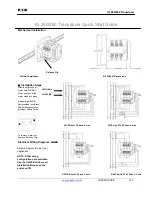
11
Circuit Description
Receive Signal Path
Incoming RF from the antenna jack is passed through
a low-pass filter and high-pass filter consisting of coils
L1022, L1024, L1026, L1027, L1030, & L1031, capacitors
C1237, C1239, C1242, C1245, C1247, C1248, C1249, C1250,
C1251, C1252, C1255, & C1257 and antenna switching di-
odes
D1037
and
D1039
(both
RLS135
) to the receiver front
end section.
Signals within the frequency range of the transceiver
are applied to the receiver front end which contains RF
amplifier
Q1058
(
2SC5226
) and varactor-tuned band-pass
filter consisting of coils L1013, L1017, L1020, L1021, L1028,
& L1029, capacitors C1198, C1204, C1205, C1212, C1216,
C1217, C1222, C1228, C1232, C1243, & C1253, and diodes
D1032
,
D1034
,
D1036
&
D1042
(all
HVC350
), then applied
to the 1st mixer
Q1056
(
2SC5226
).
Buffered output from the VCO is amplified by
Q1029
(
2SC5226
) to provide a pure 1st local signal between 143.4
and 172.4 MHz for injection to the 1st mixer. The 35.4 MHz
1st mixer product then passes through monolithic crystal
filter
XF1001
(
35S15A
, 7.5 kHz BW) which strips away all
but the desired signal, which is then amplified by mixer
postamp
Q1050
(
2SC4215Y
).
The amplified 1st IF signal is applied to the AM/FM IF
subsystem IC
Q1049
(
TK10931V
), which contains the 2nd
mixer, limiter amplifier, and AM/FM detector.
A 2nd local signal is generated by PLL reference/2nd
local oscillator
Q1045
(
2SC4116GR
) from the 17.475 MHz
crystal
X1002
. The 17.47 MHz signal is doubled by
Q1048
(
2SC4116GR
) to produce the 450 kHz 2nd IF when mixed
with the 1st IF signal within
Q1049
. The 2nd IF then pass-
es through the ceramic filter
CF1001
(
ALFYM450F=K
) to
strip away unwanted mixer products.
In the FM mode, a 2nd IF signal from the ceramic filter
CF1001
applied to the limiter amplifier section of
Q1049
,
which removes amplitude variations in the 450 kHz IF
before detection of the speech by the ceramic discrimina-
tor
CD1001
(
CDBM450C24T
). Detected audio from
Q1049
is passed through the de-emphasis, consisting of the re-
sistors R1089, R1095, R1100, & R1149, capacitors C1104,
C1105, C1107, & C1151, and
Q1028-2
(
NJM2904V
).
In the AM mode, detected audio from
Q1049
is passed
through the audio amplifier
Q1028-1
(
NJM2904V
) and
ANL circuit, then applied to the AF amplifier
Q1028-2
(
NJM2904V
). When ANL is on, the ANL MUTE gate
Q1027
(
UMG2
) goes high, the low-pass filer/limiter con-
sisting of capacitor C1124, resistors R1105, R1111, R1112,
R1115, & R1119 and diode
D1023
(
BAS316
) is activate,
thus reducing the pulse noises when impulse noise re-
ceived.
The processed audio signal from
Q1028-2
passes
through the audio mute gate
Q1008
(
DTC143ZUA
) and
the volume control to the audio power amplifier
Q1009
(
TDA7233D
), providing up to 0.4 Watts to the headphone
jack or 8
W
loudspeaker.
A portion of the AF signal from the AM/FM IF sub-
system
Q1049
converted into DC voltage within the IC,
and then passes through the AGC amplifier
Q1054
(
2SA1602A
) and
Q1055
(
UMW1
) to the inversion ampli-
fiers
Q1051
and
Q1057
(both
2SC5226
). These amplifiers
reduce the gain of the IF amplifier
Q1050
and the RF am-
plifier
Q1058
while receiving a strong signal.
Squelch Control
When a signal is received, a DC squelch control volt-
age appears at pin 15 of AM/FM IF subsystem
Q1049
ac-
cording to the receiving signal strength. This DC is ap-
plied to pin 2 of microprocessor
Q1014
.
The DC squelch control voltage is compared with the
SQL threshold level by the microprocessor
Q1014
. If the
DC squelch control voltage is higher, pin 49 of
Q1014
goes
low. This signal disable the AF MUTE gate
Q1008
(
DTC143ZUA
), thus activating the AF audio.
Also, the microprocessor stops scanning, if active, and
allows audio to pass through the AF MUTE gate
Q1008
.
Transmit Signal Path
Speech input from the microphone is passed through
the microphone sensitivity potentiometer VR1001 and
microphone amplifier
Q1005-3
(
NJM2902V
), then applied
to the ALC amplifier
Q1007
(
AN6123MS
). The amplified
speech signal is passed through the high-pass filter
Q1005-
1
(
NJM2902V
) and low-pass filter
Q1005-2
(
NJM2902V
)
which AM modulate the Tx frequency with speech sig-
nal.
When using the optional headset, the SIDETONE sig-
nal from
Q1011
(
UMG2
) becomes “HIGH”, turning
Q1012
(
2SC4116GR
) on, therefore a portion of the speech signal
applied to the AF power amplifier
Q1009
as a monitor
signal.
The carrier signal from the VCO
Q1023
(
2SC5226
)
passes through the buffer amplifier
Q1029
(
2SC5226
) and
Summary of Contents for VXA-150
Page 8: ...8 Notes ...
Page 10: ...10 Block Diagram ...
Page 16: ...16 Note ...
Page 18: ...MAIN Unit Note 18 ...












































